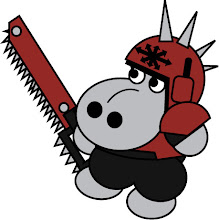We got some new white boards at the school where I teach, and the polystyrene sheets they were shipped in have been sitting in my office for a while. It's 10mm low density white stuff, about four by six feet. I've been trying to think of a use for it, but so far I have not yet had any really good ideas. I mentioned the stuff to one of my students, an avid member of the school wargames club, and he asked if he could have some. So I cut him some pieces small enough to fit his bag, and sent him on his way.
This morning I asked what he was planning to do with it, and he said he was going to use it to make bases for terrain. This got me thinking.
Years of experience have shown me that low density polystyrene doesn't make for good basing material. It's far too fragile,and tends to break up. Looking at the bottoms of any of the hills at my games club bears this out - they are all made from sheets of low density polystyrene, and all of them have ragged chunks missing from the bottoms after leading a hard life in the club terrain stash.
But when you're just starting out, making a base from polystyrene sheet makes sense, it's so easy to shape!
So I figured I'd put up an article about ensuring that your bases are sturdy enough to survive, and durable enough to see you through years of carnage. And believe me, terrain needs to be sturdy, the base especially.
Bases take a hell of a beating on any terrain item. They need to be tough, and they need to be made from something which doesn't warp. Corrugated cardboard is very tough, but it does warp. If you don't have anything else, you can minimise warping by using two layers with the corrugations running cross-wise.
Foam core is also very tough, but the edges can get a bit knocked about since they really are just polystyrene. You can try to minimise this by painting the foam parts with PVA glue, but you'll almost inevitably get dents with rough handling and poor storage. If you take reasonable care, you won't have a problem.
Then there's MDF, which is also known as Craft Wood. This stuff is very tough. Of course, you will need a saw to cut it (or a sharp knife and a LOT of patience!). It's available in a range of thicknesses, and you can usually get smaller panels from your timber yard if you don't want one of the full 4X8 foot panels. Most places will actually cut wood to size for you free of charge. MDF has the disadvantage of being more expensive and a bit harder to work with. It's also pretty heavy, so stacking terrain pieces on top of one another may lead to a bit of squishing.
You can use polystyrene for a base, but only the high density version will really work. Even then, you will probably find the edges crumble a bit if you have beveled them. A good way to prevent this is to add a bottom layer to the base made from foamcore, cardboard or MDF. This will mean the polystyrene is less exposed and less likely to get damaged.
Of course, polystyrene sheet is great for making terrain tiles and boards, but some care must be taken. On my Portheim tile set, where the edges of each tile were designed to be part of a sea wall, I painted the edges of every tile with PVA glue to add an extra layer of durability. If you will never see the edges, a good trick is to either cover them with gaffer tape, or add a wooden frame around the outside of each tile. You should also think seriously about gluing MDF to the bottom of each tile.
One final option is to use a CD for a base. This limits you to a disc about 12 cm across, but they are VERY hard to damage. It's actually a very enjoyable challenge working out a whole terrain feature to fit onto a CD.
Making your base as tough as possible will really help to make sure your terrain stays in peak condition as long as possible, but always remember to store your terrain carefully. Even the mightiest MDF base will be wrecked if you insist on kicking it around the room before throwing it in the swimming pool after all.
A Summer of Citadel: Lune and a retro den...
-
Plenty of house sorting work has kept us busy over the last few days.
Mostly stripping seven layers of painted wallpaper from the walls of one of
the be...
1 day ago
















I use Foamex which is the stuff they use for making signs. Available in 3 and 5mm, light, doesn't warp. Only prob is that it doesn't always stick well and if you use it for large flat areas, it will dent slightly if you drop something on it. On the other hand, this means you can scribe detail in fairly easily!
ReplyDelete